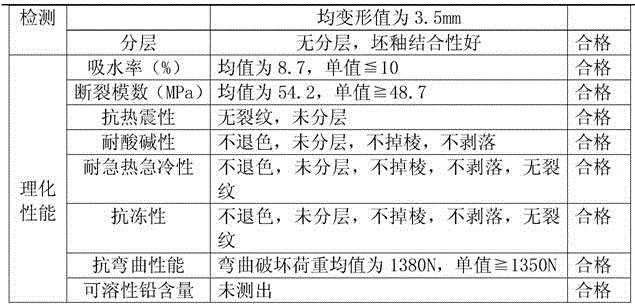Microcrystalline transparent leadless glaze-polycrystalline micropowder-ceramic composite glass tile
A technology of polycrystalline micropowder and ceramic composite, applied in the field of building materials, can solve problems such as printing screen dots, and achieve the effects of low water absorption, glaze gloss, and improved adaptability
- Summary
- Abstract
- Description
- Claims
- Application Information
AI Technical Summary
Problems solved by technology
Method used
Image
Examples
Embodiment 1
[0036] A kind of microcrystalline transparent lead-free glaze-polycrystalline micropowder-ceramic composite glazed tile, its composition comprises:
[0037] (1) Microcrystalline transparent lead-free glaze layer: 16 parts of kaolin, 20 parts of quartz, 18 parts of potassium feldspar, 12 parts of talc, 3 parts of borax, 2 parts of boric acid, 2 parts of calcium borate, 2 parts of aluminum oxide, 1 part of zinc oxide, 1 part of dolomite, 2 parts of wollastonite, 0.5 part of barium carbonate, 0.5 part of strontium carbonate, 0.5 part of lithium carbonate, 0.5 part of lanthanum oxide, 0.5 part of zirconia;
[0038] (2) Polycrystalline powder layer: 54 parts of silicon oxide, 23 parts of aluminum oxide, 0.1 part of iron oxide, 3 parts of sodium oxide, 4 parts of potassium oxide, 0.1 part of titanium oxide, 4 parts of calcium oxide, and 3 parts of magnesium oxide;
[0039] (3) Ceramic matrix layer: 15 parts of diatomite, 10 parts of kaolin, 10 parts of red mud, 10 parts of gypsum po...
Embodiment 2
[0041] A kind of microcrystalline transparent lead-free glaze-polycrystalline micropowder-ceramic composite glazed tile, its composition comprises:
[0042] (1) Microcrystalline transparent lead-free glaze layer: 20 parts of kaolin, 24 parts of quartz, 22 parts of potassium feldspar, 18 parts of talc, 5 parts of borax, 4 parts of boric acid, 4 parts of calcium borate, 4 parts of aluminum oxide, 3 parts of zinc oxide, 3 parts of dolomite, 4 parts of wollastonite, 2 parts of barium carbonate, 2 parts of strontium carbonate, 2 parts of lithium carbonate, 2 parts of lanthanum oxide, 2 parts of zirconia;
[0043] (2) Polycrystalline powder layer: 58 parts of silicon oxide, 25 parts of aluminum oxide, 1 part of iron oxide, 5 parts of sodium oxide, 8 parts of potassium oxide, 1 part of titanium oxide, 6 parts of calcium oxide, and 5 parts of magnesium oxide;
[0044](3) Ceramic matrix layer: 25 parts of diatomite, 20 parts of kaolin, 15 parts of red mud, 15 parts of gypsum powder, 15...
Embodiment 3
[0046] A kind of microcrystalline transparent lead-free glaze-polycrystalline micropowder-ceramic composite glazed tile, its composition comprises:
[0047] (1) Microcrystalline transparent lead-free glaze layer: 18 parts of kaolin, 22 parts of quartz, 20 parts of potassium feldspar, 15 parts of talc, 4 parts of borax, 3 parts of boric acid, 3 parts of calcium borate, 3 parts of aluminum oxide, 2 parts of zinc oxide, 2 parts of dolomite, 3 parts of wollastonite, 1 part of barium carbonate, 1 part of strontium carbonate, 1 part of lithium carbonate, 1 part of lanthanum oxide, 1 part of zirconia;
[0048] (2) Polycrystalline powder layer: 56 parts of silicon oxide, 24 parts of aluminum oxide, 4 parts of sodium oxide, 6 parts of potassium oxide, 5 parts of calcium oxide, 4 parts of magnesium oxide, 0.5 parts of iron oxide, and 0.5 parts of titanium oxide;
[0049] (3) Ceramic matrix layer: 20 parts of diatomite, 15 parts of kaolin, 12 parts of red mud, 12 parts of gypsum powder, ...
PUM
 Login to View More
Login to View More Abstract
Description
Claims
Application Information
 Login to View More
Login to View More - R&D
- Intellectual Property
- Life Sciences
- Materials
- Tech Scout
- Unparalleled Data Quality
- Higher Quality Content
- 60% Fewer Hallucinations
Browse by: Latest US Patents, China's latest patents, Technical Efficacy Thesaurus, Application Domain, Technology Topic, Popular Technical Reports.
© 2025 PatSnap. All rights reserved.Legal|Privacy policy|Modern Slavery Act Transparency Statement|Sitemap|About US| Contact US: help@patsnap.com


